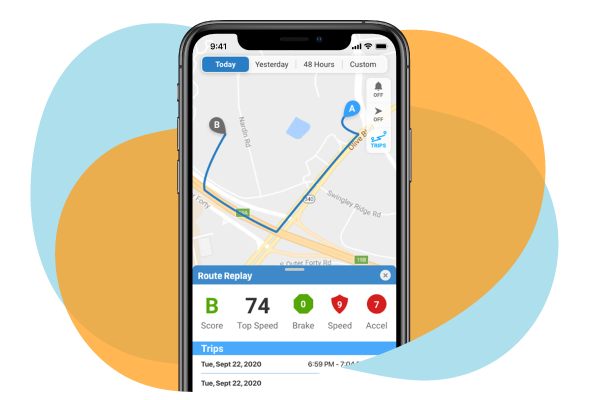
By Jana Rhodes / Posted November 23, 2015
Impaired Driving Can Affect Mental Health
Most of us know about the short term effects on mental ability and judgement that impaired driving causes, but these are not the only dangers. The potential for long-term damage to mental health exists every time an impaired driver gets behind the wheel. There are links between substance abuse and mental illness, and the risk of trauma from a car accident increases dramatically when drugs or alcohol are involved. At MOTOsafety, we are concerned about this mental health risk and are joining the fight to reduce impaired driving.
The good news is that impaired driving is declining, especially among teens, the group of drivers who MOTOsafety impacts most. According to the CDC, drinking and driving among teens has decreased by 54 percent since 1991.1 Yet this news makes the current statistics all the more shocking: 1 in 10 high school teens drink and drive for a total of 2.4 million times per month.2 Overall, alcohol-impaired driving accounts for over a third of all traffic-related deaths in the United States. The effect on those who choose to drive under this influence ranges from impaired judgement and injury to serious mental illness or death.
Caution: Intoxication can “look” normal.
A person does not have to show obvious signs of impairment to be intoxicated. In fact, many people are intoxicated before they behave like they are drunk.3 Impaired judgement can happen in this early stage, even when a person appears to be fine.3 Mental processing slows,and the ability to perform multiple tasks and decisions becomes harder. This is why field sobriety tests always involve complex tasks; the test divides attention, requiring a level of mental processing that is damaged when impaired by substance abuse.
Substance abuse often coexists with mental disorders.
Not all drivers who choose to drive impaired are regular substance abusers. However, according to MADD, the average drunk driver is arrested after they have driven drunk 80 previous times.4 Do you think that your teen just made a one-time mistake? Think again: The CDC reports that 85 percent of teens who drink and drive also binge drink. This indicates a risk of mental health; over 37 percent of those who abuse alcohol also suffer from a mental disorder.3 This can include depression, eating disorders, and personality disorders. It can even lead to suicide. The Diagnostic and Statistical Manual of Mental Disorders (DSM-5) notes that “alcohol intoxication is an important contributor to suicidal behavior” and that 44 percent of 12th-grade students reported having been drunk in 2010.5
Driving while impaired can lead to life-altering trauma.
Teens are already inexperienced drivers and are 3 times more likely than experienced adults to get into a car accident.1 This risk increases greatly when teens consume alcohol, making them 17 times more likely to die in a car accident.1 The increased risk of a car accident also means the risk of an adjustment disorder caused by trauma. These include major depressive disorder, posttraumatic stress disorder (PTSD), and personality disorders.5 A teen also has a much longer life to live and deal with a traumatic event, so it is important to protect both their physical and mental health by talking with them about impaired driving.
It’s also important to model good judgement for your teen:
- Always designate a non-drinking driver when going out with a group.
- Be firm about not letting friends drive when they have been drinking.
- Call a taxi if you have been drinking and don’t have a designated driver.
- If you serve alcohol in your home, make sure that no guests leave without a sober driver.
We recommend that parents of teen drivers have a serious discussion about impaired driving with their teen. Armed with the facts, you can take part in the effort to reduce impaired driving.
Sources:
- Teen Drinking and Driving. (2012, October 2). Retrieved November 13, 2015, from http://www.cdc.gov/vitalsigns/teendrinkinganddriving/index.html
- Impaired Driving: Get the Facts. (2015, May 19). Retrieved November 13, 2015, from http://www.cdc.gov/MotorVehicleSafety/Impaired_Driving/impaired-drv_factsheet.html
- Butcher, J., & Mineka, S. (2014). Abnormal psychology (Sixteenth ed.). Pearson.
- MADD – Drunk Driving Statistics. (n.d.). Retrieved November 13, 2015, from http://www.madd.org/drunk-driving/about/drunk-driving-statistics.html
- Diagnostic and statistical manual of mental disorders: DSM-5. (5th ed.). (2013). Washington, D.C.: American Psychiatric Association.
- National Impaired Driving Month: The Data On Why We Need It. (2015). Retrieved November 13th, 2015 from http://www.anellixavier.com/dui-foundation/national-impaired-driving-month

- Installs in seconds
- Rates driver performance
- Monitors safe driving behaviors
- Shows location in real time
- Generates alerts for speeding and more
- Signals unauthorized usage

Next Post
Tracking on the Go with a Mobile App
December 1, 2015MOTOsafety offers peace of mind for parents who have teen drivers on the road. But what if you don’t have time to watch your computer? Most parents…
Previous Post
Highway Driving: 4 Tips to Keep Yourself Safe
November 15, 2015It’s what every teen anticipates when they turns 16: a shiny new driver’s license, and a shiny new car. The prospect of getting behind the wheel and…


